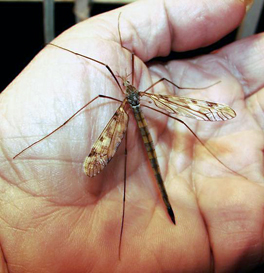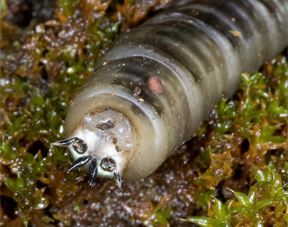On 27 December 1805, Clark signed off on his field note, perhaps with a shudder of recognition, “Musquetors troublesom.” However, in the fair copy of this day’s journal he managed to suppress his anxiety. “Musquetors to day, or an insect So much the Size Shape and appearance of a Musquetor that we Could observe no kind of difference.” We can forgive him for not noticing that the little monster had neither scales on its body, nor a long, piercing proboscis. But he must have noticed that it didn’t rush to inflict that old familiar trespass, and therefore didn’t expropriate any of his blood. And it didn’t scream in his ear. But it sure was a convincing mosquito look-alike—one of Ma Nature’s biggest little jokes.
This species is classified in the family Tipulidae, a Latin word meaning “water spider,” which happens to be one of this fly’s common names. And that is no wonder, since Tipulidae constitute the largest family of Diptera (two-wingers) in the world, numbering roughly 1,517 different species in the U.S. and Canada alone. Given a family that large one might expect to learn that there must be a few that deserve some acknowledgement for services rendered or damages done. But it seems the best that can be said of any of them is that even though they may look somewhat like overgrown mosquitoes—adult body length, 1″; wingspan up to 3″—they don’t act like them.
Many of the larvae of T. abdominalis—known as “leatherjackets” on account of their thick integuments (casings)—which represent the worm stage of the metamorphosis that produces the fragile, gangling mini-monster we know as the crane fly, are not as guiltless as their parents. Subterranean larvae feed on the roots of many grasses, as well as on decomposing grass cuttings. Although some are small—in length about equal to half the diameter of a penny,—other T. abdominalis larvae may attain a length of over two inches, and a diameter of up to 10 mm (nearly ½ in). Between and beside the large, wide-set eyes are pointed bristles called setae (SET-eye), which serve to protect the larva’s face.[1]Ross H. Arnett, Jr., American Insects: A handbook of the insects of America north of Mexico (New York: Van Nostrand Reinhold, 2000), 850.
A large community of them can visibly damage a well manicured lawn or putting green. However, that’s only because we mow our yards and golf courses regularly throughout the growing season, and water them methodically, creating a subterranean supermarket of leatherjackets’ comestibles. Aquatic larvae belong to the feeding group called “shredders,” because they break fallen leaves into smaller pieces, and thereby provide accessible forage to other organisms. Also, they help to clean up their living space by feeding on decaying water plants.[2]R. W. Bouchard, Jr., “Guide to aquatic macroinvertebrates of the Upper Midwest.” Water Resources Center, University of Minnesota, St. Paul. p. 183. Charles Paul Alexander, “The … Continue reading
This wasn’t the expedition’s first encounter with a “water spider.” Way back on 27 March 1804, Lewis posted in the day’s “Remarks” that he had seen some large insects resembling mosquitoes, but that didn’t seem right. “They attempted to bit[e] my horse,” he wrote, “but I could not observe that they made any impression with their Beaks.”
Notes
| ↑1 | Ross H. Arnett, Jr., American Insects: A handbook of the insects of America north of Mexico (New York: Van Nostrand Reinhold, 2000), 850. |
|---|---|
| ↑2 | R. W. Bouchard, Jr., “Guide to aquatic macroinvertebrates of the Upper Midwest.” Water Resources Center, University of Minnesota, St. Paul. p. 183. Charles Paul Alexander, “The Crane-Flies of New York,” Part II. Biology and phylogeny.” Cornell University Agricultural Experiment Station, Memoir 38 (June 1920). |
Experience the Lewis and Clark Trail
The Lewis and Clark Trail Experience—our sister site at lewisandclark.travel—connects the world to people and places on the Lewis and Clark Trail.
Discover More
- The Lewis and Clark Expedition: Day by Day by Gary E. Moulton (University of Nebraska Press, 2018). The story in prose, 14 May 1804–23 September 1806.
- The Lewis and Clark Journals: An American Epic of Discovery (abridged) by Gary E. Moulton (University of Nebraska Press, 2003). Selected journal excerpts, 14 May 1804–23 September 1806.
- The Lewis and Clark Journals. by Gary E. Moulton (University of Nebraska Press, 1983–2001). The complete story in 13 volumes.



